Scottish Crime and Justice Survey 2014/15: Partner Abuse
Results from the Partner Abuse module of the 2014/15 Scottish Crime and Justice Survey.
2. The Overall and Varying Risk of Partner abuse
2.1 Summary of findings
Partner abuse is commonly experienced on multiple occasions, over a long period of time. Over two-thirds (67.5%) of those who reported an incident of partner abuse in the last 12 months also reported at least one incident prior to this period. The risk of partner abuse varied by gender, age, access to money and deprivation, and other types of victimisation.
- Overall, 14.1% of respondents had experienced partner abuse since the age of 16, and 2.9% of respondents had experienced partner abuse in the last 12 months. The risk of partner abuse in the last 12 months did not change between the 2012/13 and 2014/15 survey sweeps.
- A higher proportion of women than men experienced partner abuse in the last 12 months, at 3.4% and 2.4% respectively.
- However, a much higher proportion of women had experienced partner abuse (physical or psychological) since the age of 16 (18.5% of women, compared to 9.2% of men).
- The risk of partner abuse (in the last 12 months) was highest amongst young people aged 16 to 24 years (6.9%) and lowest amongst those aged 65 or over (0.4%).
- Nineteen per cent of respondents living in the 15% most deprived areas of Scotland had experienced partner abuse since the age of 16, compared to 13.2% of those living in the rest of Scotland.
- Almost a quarter (22.5%) of respondents classified as victims of crime in the main SCJS survey had experienced partner abuse since the age of 16, compared to 12.6% of those who were not classified as victims.
2.2 Introduction
This chapter presents the findings on the extent of partner abuse amongst adults in Scotland. The chapter examines the overall and varying prevalence and incidence of partner abuse, since age 16 and in the last 12 months. Note that using the SCJS definition, partner abuse can only occur if someone had a partner at the time. Almost all survey respondents (93.3%, n = 9,312) reported having had at least one partner since the age of 16, and 69.3% (n = 6,925) of all survey respondents reported having contact with a partner or ex-partner in the last 12 months.
2.3 Overall risk of SCJS partner abuse
Overall, 14.1% of respondents ( n = 9,312) had experienced at least one incident of partner abuse, either psychological or physical, since the age of 16.
The risk of psychological abuse was higher than the risk of physical abuse. Breaking this down further, 12.2% of respondents experienced at least one incident of psychological abuse since the age of 16, 9.6% reported at least one incident of physical abuse, and 7.7% reported both psychological and physical abuse.
Looking at the last 12 months only, 2.9% of respondents experienced at least one incident of partner abuse. Within this group, 2.5% reported at least one incident of psychological abuse, and 1.5% reported at least one incident of physical abuse. Figure 2.1 summarises these results.
Figure 2.1 Risk of experiencing partner abuse since age 16 and in the last 12 months
SCJS 2014/2015
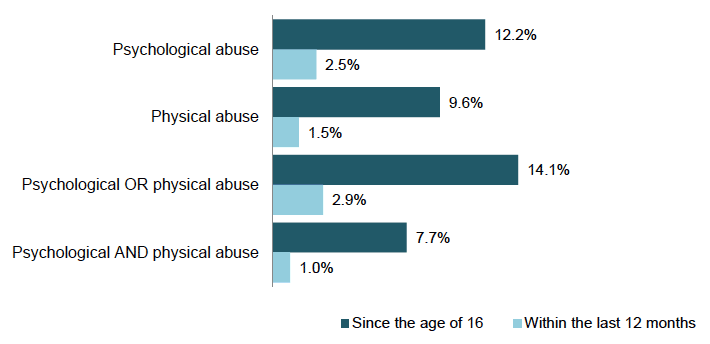
Base: All respondents with a partner since age 16 (9,312) , all respondents with contact with a partner/ex-partner in the last 12 months (6,925)
Variable name: DA_1i_ANY DA_1iii_ANY DA_ANYEV DA_ANY12 DA_BOTH12 REL_0i
2.4 Risk of partner abuse over time
Table 2.1 shows the trends in the risk of partner abuse since age 16 between 2008/09 and 2014/15. [8]
Between 2008/09 and 2014/15, the overall risk of experiencing any partner abuse saw a decrease from 18.2% to 14.1%. Looking at the different types of abuse in this period, the risk of psychological abuse decreased from 15.1% to 12.2%, whilst the risk of physical abuse decreased from 13.2% to 9.6%. [9]
Looking just at the last two survey sweeps, there was no statistically significant change in the risk of partner abuse (psychological and physical) between 2012/13 and 2014/15.
Table 2.1 Risk of partner abuse since the age of 16, 2008/09 to 2014/15
| 2008/09 | 2009/10 | 2010/11 | 2012/13 | 2014/15 | % change 2008/09-2014/15 | % change 2012/13-2014/15 | |
|---|---|---|---|---|---|---|---|
| Psychological abuse | 15.1% | 13.4% | 13.4% | 12.0% | 12.2% | -2.8%* | 0.4% |
| Physical abuse | 13.2% | 11.9% | 12.0% | 9.2% | 9.6% | -3.7%* | 0.4% |
| Any psychological or physical abuse | 18.2% | 16.4% | 16.3% | 13.8% | 14.1% | -4.2%* | 0.3% |
| Both psychological and physical abuse | 10.0% | 8.9% | 9.1% | 7.4% | 7.7% | -2.3%* | 0.3% |
| Base | 10,110 | 12,729 | 10,397 | 9,648 | 9,312 |
SCJS changes which are statistically significant at the 95% level are highlighted with an *
Bases: All respondents who had a partner since the age of 16
Variable names: DA_1i_ANY DA_1iii_ANY DA_ANYEV
Table 2.2 below shows the trend in the risk of partner abuse in the last 12 months, between 2008/09 and 2014/15. [10]
Between 2008/09 and 2014/15, the overall risk of experiencing any partner abuse decreased from 4.2% to 2.9%. Looking at the two categories of partner abuse, the risk of psychological abuse decreased from 3.4% to 2.5%, and the risk of physical abuse decreased from 2.2% to 1.5%.
Looking just at the last two survey sweeps, between 2012/13 and 2014/15, the risk of partner abuse, both psychological and physical, did not change. The small difference in the risk of psychological abuse shown in Table 2.2 (2.3% and 2.5% respectively) is not statistically significant, whilst in both sweeps, 1.5% had experienced physical abuse.
Table 2.2 Risk of partner abuse (in last 12 months), 2008/9 to 2014/15
SCJS 2008-09 to 2014/2015
| 2008/09 | 2009/10 | 2010/11 | 2012/13 | 2014/15 | % change 2008/09-2014/15 | % change 2012/13-2014/15 | |
|---|---|---|---|---|---|---|---|
| Psychological abuse | 3.4% | 2.9% | 2.4% | 2.3% | 2.5% | -0.9%* | 0.1% |
| Physical abuse | 2.2% | 1.7% | 1.7% | 1.5% | 1.5% | -0.7%* | 0.0% |
| Any psychological or physical abuse | 4.2% | 3.5% | 3.1% | 2.8% | 2.9% | -1.3%* | 0.1% |
| Both psychological and physical abuse | 1.4% | 1.1% | 1.1% | 1.0% | 1.0% | -0.4% | 0.0% |
| Base | 6,748 | 9,471 | 7,652 | 7,180 | 6,925 |
SCJS changes which are statistically significant at the 95% level are highlighted with an *
Base: All who have had contact with a partner in the last 12 months
Variable names: DA_ANYEV DA_ANY12 REL_0i
Figures in this table are rounded to maintain compatibility with previous reports. The equivalent data to one decimal point is shown in Figure 2.1.
2.5 The varying risk of partner abuse
The risk of partner abuse in Scotland varied by different population characteristics. This section examines the relationship between gender, age and socio-economic status on the risk of partner abuse, since the age of 16 and in the last 12 months. Note that the analysis examines these factors in isolation, and that more advanced statistical modelling would be required to establish the combined or interactive effects of each factor.
2.5.1 Gender
Looking at the 12 month period, the overall risk of partner abuse was higher for women than men, at 3.4% and 2.4% respectively [11] .
Women were more likely to experience psychological abuse than men, at 3.1% and 1.9% respectively. However, the risk of physical abuse did not vary between men and women, at 1.4% and 1.5% respectively.
Looking at the longer time period, there were statistically significant differences in victimisation between men and women. The overall risk of partner abuse since the age of 16 women was around two times the level reported by men, at 18.5% and 9.2% respectively.
A higher proportion of women than men reported psychological abuse since the age of 16 (16.5% women, compared to 7.5% men respectively). Likewise, the proportion of women reporting physical abuse was higher, at 12.8% and 5.9% respectively. Table 2.3 shows the results.
Table 2.3 Risk of partner abuse in the last 12 months and since age 16, by gender (%)
| In last 12 months | Since age 16 | |||
|---|---|---|---|---|
| In last 12 months | Men | Women | Men | Women |
| Psychological abuse | 1.9% | 3.1% | 7.5% | 16.5% |
| Physical abuse | 1.4% | 1.5% | 5.9% | 12.8% |
| Psychological or physical abuse | 2.4% | 3.4% | 9.2% | 18.5% |
| Both psychological and physical abuse | 0.9% | 1.2% | 4.2% | 10.9% |
Base: All respondents with a partner since age 16 (men 4,167, women 5,145), all respondents with contact with a partner/ex-partner in the last 12 months (men 3,319, women 3,606)
Variable names: DA_1i_ANY DA_1iii_ANY DA_ANYEV DA_ANY12 DA_BOTH12 QDGEN REL_0i
Box 2.1 Gender symmetry and asymmetry
The results in Section 2.4.1 show that there is a small, but statistically significant, difference in the overall risk of partner abuse within the last 12 months. A number of studies have reported equal or near equal victimisation rates for men and women. These include the 1996 British Crime Survey [ BCS] (Mirrlees-Black 1999), and 2001 BCS (Walby & Allen 2004), as well as large-scale national surveys in North America.
However, when respondents are asked about their experiences of partner abuse since the age of 16, a much larger proportion of women than men report experiences of abuse. Rather the longer-term measure shows that the risk of psychological and phsyical partner abuse was higher amongst women than men.
This asymmetrical finding is consistent with a body of academic research that distinguishes between situational and coercive partner abuse (Johnson, 2001, 2006). For example, analysis of data from the Crime Survey of England and Wales (Myhill, 2015) indicates that 'coercive control is highly gendered and is significantly more damaging to its primarily female victims than is situational violence'.
2.5.2 Risk of different types of partner abuse and gender
Psychological abuse
Respondents were asked if they had experienced twelve different types of psychological abuse since the age of 16.
Overall, the most commonly reported form of psychological abuse was a partner behaving in a jealous or controlling way (7.6%), followed by being put down repeatedly, and made to feel worthless (6.4%). A further 4.5% stated that a partner had threatened to hurt them, and 4.3% said that a partner had stopped them from seeing friends and relatives.
However, these findings were highly gendered. Across all twelve categories, the proportion of women that reported abuse was higher than the proportion of men. For example:
- 10.9% of women had experienced a partner behaving in a jealous or controlling way, compared to 3.9% of men;
- 9.9% of women experienced being repeatedly put down, and made to feel worthless, compared to 2.4% of men, and;
- 7.0% of women said that their partner had threatened to hurt them, compared to 1.7% of men.
Figure 2.2 shows the risk of different types of psychological abuse since the age of 16, broken down by gender.
Figure 2.2 Risk of different types of psychological abuse since age 16, by gender (%)
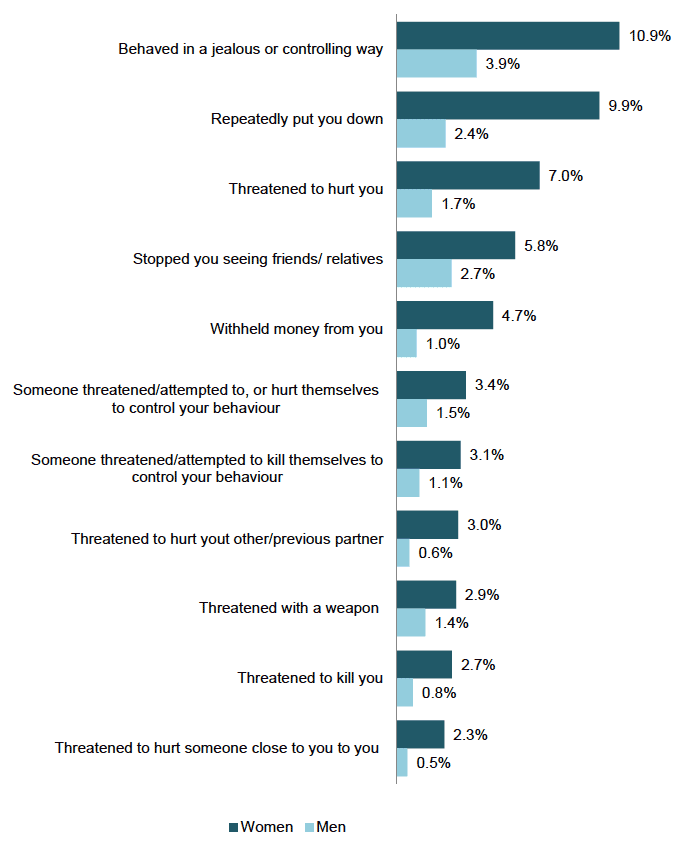
Base: All respondents with a partner since age 16: men (4,167) women (5,145)
Variable names: DA_1i_ QDGEN
Physical abuse
Respondents were asked if they had experienced seven different types of physical abuse since the age of 16.
Figure 3.3 shows the risk within each category by gender. Again, the risk of physical abuse was higher for women in all seven categories. The most common type of physical abuse amongst women was being pushed or held down, which was reported by 8.4% of female respondents, compared to 1.3% of male respondents, followed by being kicked, bitten or hit, which was reported by 6.9% of women, compared to 3.3% of men.
Figure 2.3 Risk of different types of physical abuse since age 16, by gender (%)
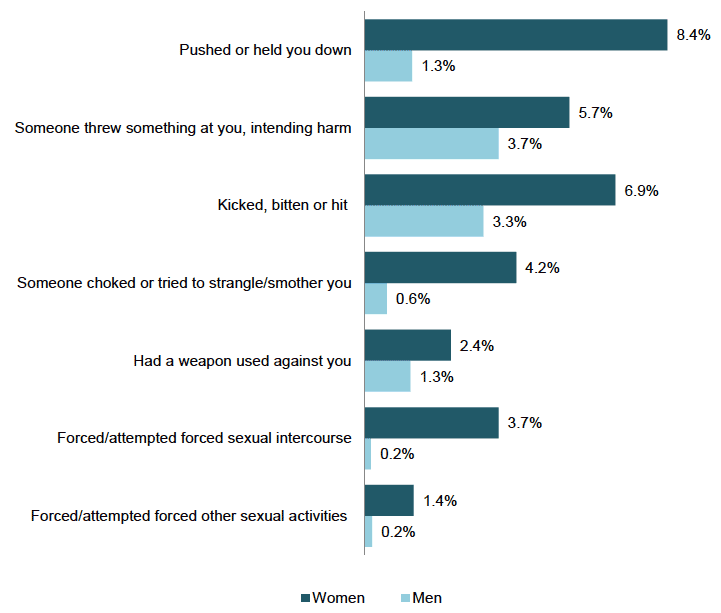
Base: All respondents with a partner since age 16: men (4,167) women (5,145)
Variable names: DA_1iii_ QDGEN
2.5.3 Age
The risk of partner abuse varied by age, both within the last 12 months, and since the age of 16.
Table 2.4 shows the risk of partner abuse in the last 12 months was highest among the 16 to 24 years age-group at 6.9%. Amongst the 55 to 64 years age-group, the equivalent figure was 1.4%, whilst those aged 65 or over were least likely to report partner abuse, either in the last 12 months, or since age 16. Looking at partner abuse since the age of 16, the risk was highest amongst the 35 to 44 years age-group, at 19.0%, and lowest amongst those aged 65 or over, at 5.0%.
Table 2.4 Risk of partner abuse (psychological or physical) in last 12 months and since age 16, by age (%)
| Age group | Within the last 12 months (%) | Since age 16 (%) |
|---|---|---|
| 16 to 24 years | 6.9% | 15.4% |
| 25 to 34 years | 3.8% | 17.8% |
| 35 to 44 years | 3.2% | 19.0% |
| 45 to 54 years | 2.8% | 18.0% |
| 55 to 64 years | 1.4% | 12.2% |
| 65 years or over | 0.4% | 5.0% |
Base: All respondents with a partner since age 16 (9,312), all respondents with contact with a partner/ex-partner in the last 12 months (6,925)
Variable names: DA_ANYEV DA_ANY12 QDAGE (in age groups) REL_0i
Taking this analysis further, Table 2.5 shows the risk of partner abuse broken down by age and gender.
Table 2.5 Risk of partner abuse (psychological or physical) in last 12 months and since age 16, by age and gender (%)
| Age group | Within the last 12 months (%) | Since age 16 (%) | ||
|---|---|---|---|---|
| Male | Female | Male | Female | |
| 16 to 24 years | 5.7% | 8.0% | 11.4% | 19.1% |
| 25 to 34 years | 3.5% | 4.1% | 12.3% | 23.0% |
| 35 to 44 years | 2.8% | 3.6% | 12.6% | 25.0% |
| 45 to 54 years | 2.1% | 3.5% | 10.8% | 24.5% |
| 55 to 64 years | 1.7% | 1.0% | 7.4% | 16.6% |
| 65 years or over | 0.2% | 0.7% | 2.6% | 7.0% |
Base: All respondents with a partner since age 16 (9,312) , all respondents with contact with a partner/ex-partner in the last 12 months (6,925)
Variable names: DA_ANYEV DA_ANY12 QDGEN QDAGE (in age groups) REL_0i
Table 2.5 shows that within the last 12 months, the risk of partner abuse was highest for young women aged 16 to 24, at 8.0%. This finding is generally consistent with other UK and international surveys, which show that women under 25 are at highest risk of experiencing abuse in the past year (Mirrlees-Black 1999, Walby & Allen 2004). See Box 2.3 for a further discussion of abusive relationships and age.
Looking at the longer term period, the risk of partner abuse was highest amongst women aged 35 to 44 years: a quarter of women in this age group had experienced partner abuse since the age of 16.
Box 2.3 Abusive relationships and age
It is important to note that the findings presented above may reflect a greater willingness amongst younger women to disclose violence (Mirrlees-Black 1999, Bunge & Locke 2000) and that some studies have found no association between the risk of partner abuse and age (Gillioz 1997).
Only 7% of women in the 65 years or over age-group reported experiences of partner abuse since the age of 16. This result is lower than might be anticipated, given that life-time prevalence would be expected to increase with age. The underlying explanation is outwith the scope of this report; however, it may be that older people are less willing to report their experiences, or there may be a cohort effect, whereby older people were less likely to experience partner abuse than later cohorts.
In a review of the available literature on partner abuse and age, Barnish found varying relationships between different types of partner abuse and age (2004, p.27). For example, some studies found a curvilinear relationship, with women under 30 and those over 50 at greater risk (Black et al 2001). A study by Piispa (2002) reported that for a substantial group of older women, physical violence decreased with time, but was replaced by ongoing psychological abuse.
2.5.4 Deprivation and available income
The risk of partner abuse varied significantly in terms of neighbourhood deprivation both since the age of 16, and in the last 12 months. Around one in five (19.0%) of those living in the fifteen per cent most deprived areas of Scotland reported abuse since age 16, compared to 13.2% of those living in the rest of Scotland. Similarly, 4.1% of those living in the fifteen per cent most deprived areas reported abuse in the last 12 months, compared to 2.7% of those living in the rest of Scotland.
These findings are broadly consistent (but not directly comparable) with findings from the Crime Survey for England and Wales [12] , which show that women living in households in the 20% most deprived areas of England were more likely to be victims of domestic abuse (9.1%), compared to women in other areas (5.6% for the 20% least deprived areas and 6.7% in other areas).
2.5.4.1 Available income
The risk of SCJS partner abuse was also associated with available income, both since the age of 16, and in the last 12 months. Respondents were asked how easy it would be for the household to find £100 to meet an unexpected expense. Unlike measures of neighbourhood deprivation, this question addresses the issue of immediate access to funds within a household. See Box 2.4 for a further discussion of this measure, as used in analysis of the British Crime Survey.
The risk of partner abuse since the age of 16 was higher amongst those who stated that it would be 'a big problem' or 'impossible' to find £100 to meet an unexpected expense, compared to those who stated it would be 'no problem', at 31.3% and 11.1% respectively.
Similarly, the risk of partner abuse in the last 12 months was higher amongst those who said it would be 'a big problem' or 'impossible' to find £100 to meet an unexpected expense, compared to those who said that it was not a problem, at 7.7% and 1.9% respectively. Figure 2.4 presents these findings and Box 2.5 provides further context to these findings.
Box 2.4 Available income and gender.
This measure was used in a Home Office research study on domestic abuse using British Crime Survey [13] data. The study highlighted that the ability to find £100 at short notice is associated with a sizeable difference in risk for both men and women. It is especially the case for women and especially for domestic violence.
The research found that Women are three and a half times more likely to be subject to domestic violence if they found it impossible to find £100 at short notice than if this was no problem, while for men the ratio is two and a half.
The SCJS found no difference in experiences of partner abuse between men and women who would find it a 'big problem' or 'impossible' to find £100 to meet an unexpected expense.
However, Section 3.3.1 highlights gender differences in the types of psychological abuse experienced, indicating that more women experience a partner stopping them having access to household money, or taking money from them (25.5% of women, compared to 10.6% of men).
Figure 2.4 Risk of partner abuse since age 16, and whether the respondent's household could find £100 to meet an unexpected expense (%)
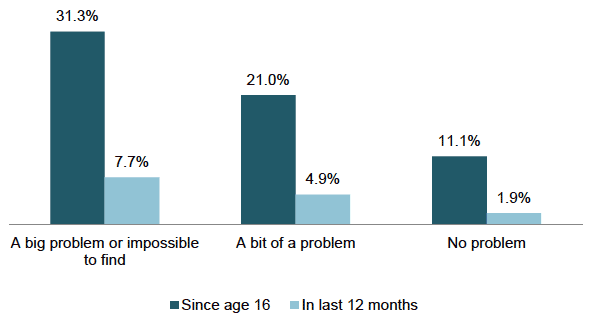
Variable names: DA_ANYEV, DA_ANY12, QDi100 (refused and don't know responses not shown) REL_0i.
Base: All respondents with a partner since age 16 (9,312), all respondents with contact with a partner/ex-partner in the last 12 months (6,925)
Box 2.5 Abusive relationships and deprivation
The findings in this report are consistent with British Crime Survey data that found women in lower income households and/or living in council properties were at significantly greater risk of partner abuse (Mirrlees-Black 1999, Walby & Allen 2004).
The relationship between partner abuse and deprivation is complex. For example, it may be that financial pressure exacerbates the risk of partner abuse. Alternatively, it may be that economic resources can make it easier to leave abusive relationships ( WHO 2002, Campbell 2002, Walby & Allen 2004). Saunders (2002) found that women in employment, with comparatively higher socio-economic status were more likely to leave abusive relationships. In this respect, higher socio-economic status may provide some protection against the risk of partner abuse recurring.
2.5.5 Victim status
The risk of partner abuse was associated with other types of victimisation. Almost a quarter (22.5%) of those who classified as victims [14] in the main SCJS survey had experienced partner abuse at least once since the age of 16. This compares to 12.6% of those who were not classified as victims.
Looking at the shorter 12 month period, 6.0% of those classified as victims in the main SCJS survey had experienced at least one type of partner abuse, compared to 2.3% of those who were not classified as victims.
2.6 Frequency of partner abuse
Respsondents who reported partner abuse within the last 12 months ( n = 238) were asked how many incidents of abuse they had experienced within this time period. Overall, 37.3% had experienced one incident, 9.4% experienced two incidents, 4.7% experienced three incidents, and 9.5% experienced four or more incidents. A further 5.3% said that there were too many incidents to count. Overall, around a third of respondents said that they either didn't know (17.0) or didn't want to answer (17.0%). Figure 2.5 below presents the findings.
The incidence of abuse varied by gender. Of those who had experienced partner abuse in the last 12 months, a higher proportion of men than women reported only one incident (48.2% men, compared to 29.6% women). There was no difference in the proportion of males and females reporting more than one experience of abuse (29.8% and 28.2% respectively), however, a higher proportion of women than men didn't wish to answer this question (22.5% women, compared to 9.2% of men) [15] .
Figure 2.5 Partner abuse incidents experienced in the last 12 months (%)
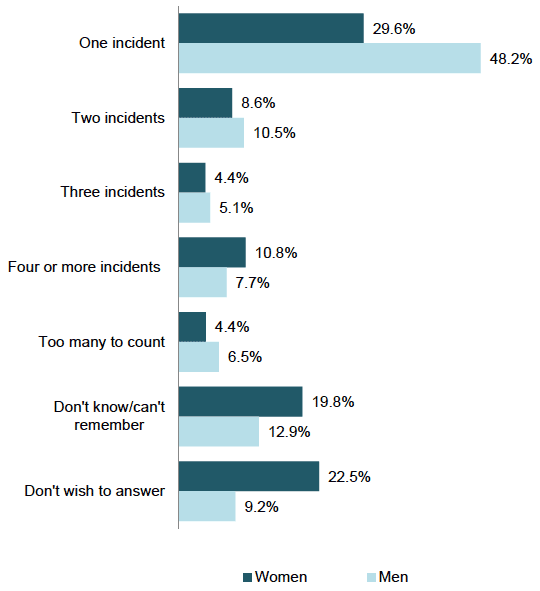
Base: Adults who had experienced partner abuse (psychological or physical) in the last 12 months (men 89, women, 149)
Variable name: DA_6
Contact
There is a problem
Thanks for your feedback